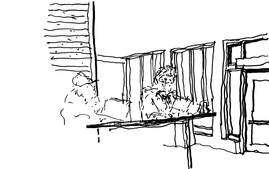From Efficiency to Revenue: How Design Can Impact Your Business
When my grandfather, a gregarious, outspoken Doctor of Osteopathy heard I was studying Interior Design, he remarked, “I don’t want some dumb broad telling me what to put in my house.” His belief was that anyone with any intellectual capability should study in the field of medicine. Had I not been so startled by his reaction, I should have responded with “Would you want a smart woman organizing effective traffic flow and specifying durable, antibacterial surfaces in your hospital?”
Interior designers, beyond being notorious tastemakers, offer a whole spectrum of benefits to your design projects, ultimately increasing sales revenue. Designers make plans, design lighting schemes, organize activity zones, check for ergonomics and important clearances, and look out for occupants’ safety, all presented in a visually appealing design. Think of your Designer as an advocate for humanity. It is his or her job to ensure that a space inside a building accommodates and enriches the human life and activities taking place within. It is a carefully orchestrated balance of form and function through space planning and finishes.
Steve Jobs said, “Design is not just what it looks like and feels like. Design is how it works.” Public safety, accessibility, adequate lighting, and general usability are all within the scope of Interior Design. Retail and hospitality spaces need to attract and accommodate new and repeat customers. Ergonomics and human metrics used by a knowledgeable designer can improve appeal to a broad range of customers. Medical facilities must be efficient and sanitary through use of particular countertops, flooring and wall paint.
Floors must be free of trip hazards and passages must be wide enough for gurneys, wheelchairs and medical personnel hurrying through the space. Even subtleties like using lighting design to create a natural sense of wayfinding are within the designer’s toolset. In retail, lighting, layout, and color combinations can direct customers to new product and where to find the customer service desk.
On the other side of the balance, beauty, timeliness, professionalism and the general attitude of a place are set by its interior. Capable designers are trained in color theory and aware of current trends, able to craft not only efficiency, but an overall tone and experience. The success of a hospitality business, for instance a spa or salon, depends on its physical setting, a tone that projects a sense of welcome combined with professionalism. A well-appointed interior shows respect for customers, clients, and patients and their experience while patronizing your business. Expectations can be raised or lowered based on our surroundings in a new situation. Restaurants are frequently assessed by potential customers based on their appearance, and the dining experience begins even before the food arrives. Especially in urban settings where competition can be intense, atmosphere and the general mood of a business matters.
Finding a qualified Interior Designer can be difficult for would-be clients. Established architecture firms often have Interior Designers on staff who are used to working with architects and contractors. Get in touch with Dean Alan Architects to discuss your project. We’d love to help.
Interior designers, beyond being notorious tastemakers, offer a whole spectrum of benefits to your design projects, ultimately increasing sales revenue. Designers make plans, design lighting schemes, organize activity zones, check for ergonomics and important clearances, and look out for occupants’ safety, all presented in a visually appealing design. Think of your Designer as an advocate for humanity. It is his or her job to ensure that a space inside a building accommodates and enriches the human life and activities taking place within. It is a carefully orchestrated balance of form and function through space planning and finishes.
Steve Jobs said, “Design is not just what it looks like and feels like. Design is how it works.” Public safety, accessibility, adequate lighting, and general usability are all within the scope of Interior Design. Retail and hospitality spaces need to attract and accommodate new and repeat customers. Ergonomics and human metrics used by a knowledgeable designer can improve appeal to a broad range of customers. Medical facilities must be efficient and sanitary through use of particular countertops, flooring and wall paint.
Floors must be free of trip hazards and passages must be wide enough for gurneys, wheelchairs and medical personnel hurrying through the space. Even subtleties like using lighting design to create a natural sense of wayfinding are within the designer’s toolset. In retail, lighting, layout, and color combinations can direct customers to new product and where to find the customer service desk.
On the other side of the balance, beauty, timeliness, professionalism and the general attitude of a place are set by its interior. Capable designers are trained in color theory and aware of current trends, able to craft not only efficiency, but an overall tone and experience. The success of a hospitality business, for instance a spa or salon, depends on its physical setting, a tone that projects a sense of welcome combined with professionalism. A well-appointed interior shows respect for customers, clients, and patients and their experience while patronizing your business. Expectations can be raised or lowered based on our surroundings in a new situation. Restaurants are frequently assessed by potential customers based on their appearance, and the dining experience begins even before the food arrives. Especially in urban settings where competition can be intense, atmosphere and the general mood of a business matters.
Finding a qualified Interior Designer can be difficult for would-be clients. Established architecture firms often have Interior Designers on staff who are used to working with architects and contractors. Get in touch with Dean Alan Architects to discuss your project. We’d love to help.



